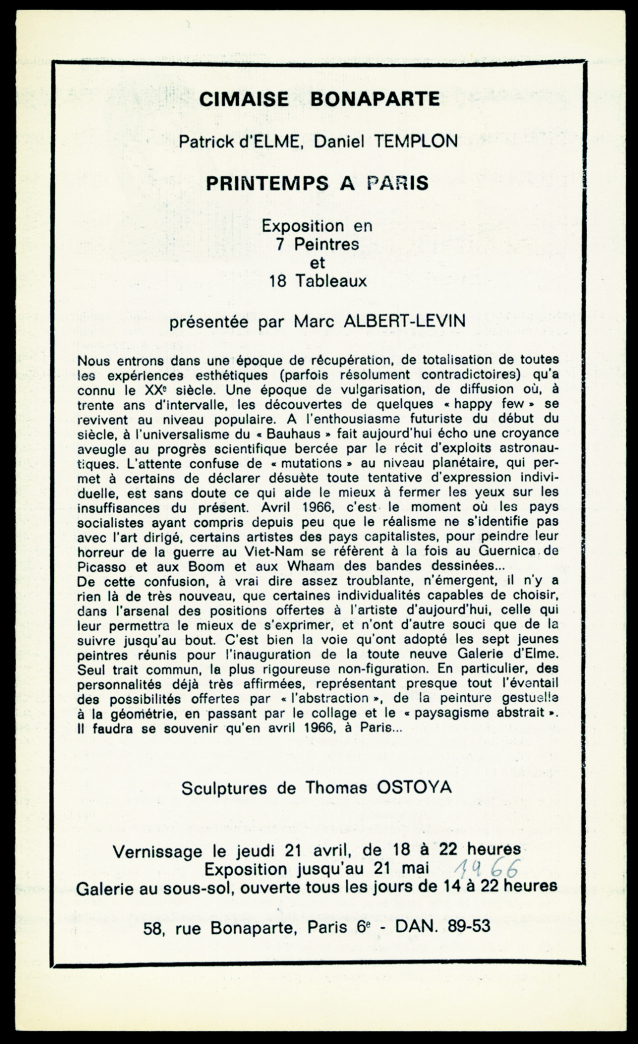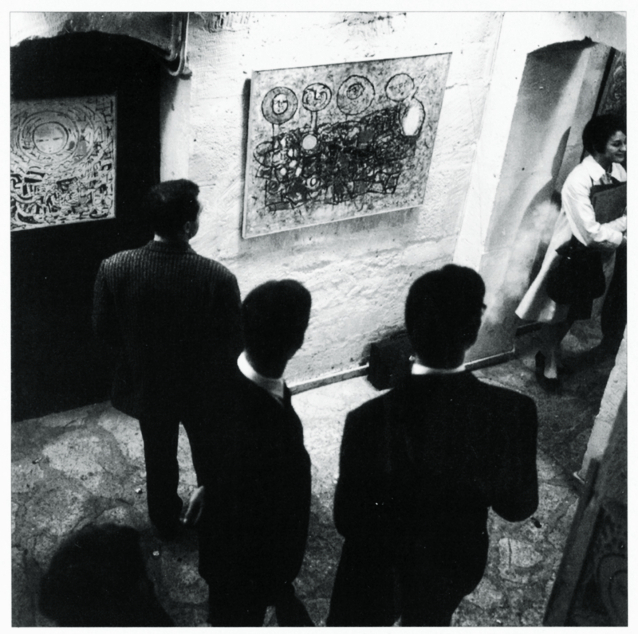History
A new gallery in Paris
Un printemps à Paris
58, rue Bonaparte — Paris
“A new gallery: a cellar at the back of an antique dealer’s shop, to be more precise: the Cimaise Bonaparte. You mustn’t let yourself be easily influenced. We see so many mediocre works hung on gold nails on moire hangings that these days it’s more likely to be on leprous walls. It’s a charming room, and what you see here is enough to encourage you to visit the basement, coming down the stairs of a vertiginous staircase.
Seven artists, two women and five men, make up this core group that we will be seeing again in the same gallery.
Some of them are already well known, such as the Japanese artist Ado and his symbols of uncompromising purity, the Vietnamese artist Hamisky, and the Yugoslav artist Ivackovic, who stood out at the last Paris Biennial for his bold black graphics. The Japanese artist Saka deserves to be better known; he is a poet who does not deny his country.
Laksine is a vigorous and expressive painter, while Jampeler is a poet and colourist. The revelation for me is Michel Tyszblat, a painter with a refined style who truly masters the art of painting, a poet whose approach might at first seem hesitant but whose immense potential is easy to see.
Georges Boudaille, Les Lettres française – 5 May, 1966
Marie Raymond
De retour parmi nous
May 26 – June 25, 1966
Paris, which so easily resents the injustice of others, is even more indignant about its own. It has become a law of the art world: indulgence and even complacency for all newcomers; oblivion for all those who do not constantly draw attention to themselves.
This was the ransom Marie Raymond paid for her discretion. In the aftermath of the last war, many of us were enthusiastic about the work of this southerner, whom we had just discovered at the Salon des Réalités Nouvelles and the Salon de Mai. It was a delicate yet powerful melody born of the rhythms of color.
What a colorist! Her lively reds, pinks and mauves contrasted harmoniously with her acid, brutal and luminous greens, giving rise to a subtle, nuanced poetry that has never faded from our memory.
Georges Boudaille, Text of invitation card, May 1966
Ado
October 6 – November 5, 1966
If we want to see Ado as a modern painter, a study of his work quickly reveals that, in truth, it’s part of a search for a past, for lost time, for centuries of human civilization. The artist’s language, new and repetitive at the same time, is not explored, but called upon to provide its constitutive elements. […]
This painting manifests a beginning and an ultimate end, leaving space for a meditation on the world of the “given”, of Creation. A painting, it seems to me, that not only expresses its own joy and decorative joyfulness, it also expresses its own tragedy, which is the tragedy of “modern” painting, but a painting that echoes the thinking of certain “pessimistic” philosophers of our time, who believe that if you’re caught in a circle, you won’t be able to get out.
Pr. Nicolas Klecker, Excerpt from Letzburgerland, Luxembourg, June 24, 1966



